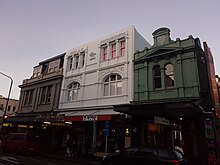 | |
| Length | 0.925 km (0.575 mi)[1] |
|---|---|
| Location | Te Aro, Wellington |
| Postal code | 5012 |
| Coordinates | 41°17′37″S 174°46′32″E / 41.2935°S 174.7756°E |
| Upper end | Mount Cook |
| Lower end | Te Ngākau Civic Square |
| Other | |
| Known for | Contributions to New Zealand's culture |

Cuba Street is a prominent city street in Wellington, New Zealand. Among the best known and most popular streets in the city, the Cuba precinct has been labelled Wellington's cultural centre, and is known for its high-per-capita arts scene the world over.[2][3]
Cuba Street and the surrounding area (known as the Cuba Street Precinct), known for its bohemian nature, boasts scores of cafés, op-shops, music venues, restaurants, record shops, bookshops, heritage architecture of various styles, and a general "quirkiness"[4] that has made it one of the city's most popular tourist destinations.[5][2] A youth-driven location, the partly pedestrianised Cuba Street is full of shoppers and city-dwellers all year round.[2][6]
Developed at the point of colonisation on Te Ati Awa land, Cuba Street runs south from the CBD of Wellington in the inner city, and was originally full of very basic homes built into the forest, such as "the Old Shebang".[7] Contrary to colloquial assumption that the street is named after Cuba, it is actually named after an early New Zealand Company settler ship, the Cuba, which arrived in Wellington Harbour on 3 January 1840. Many coffeeshops and restaurants take this misinterpretation in their stride, having names and colours that reference the island nation of Cuba.[8][9] The street's historic buildings, spanning Edwardian, Art Deco, and various weatherboard styles, were completed from the 19th-20th centuries. From the 1970s to early 80s, the street became the red light district of Wellington, and a sign of solidarity against New Zealand's laws making homosexual acts illegal until 1986. The street's rainbow crossing and icons of local drag queen and activist Carmen Rupe commemorate this.[10][2]
The section between Dixon Street and Ghuznee Street is a pedestrian mall, with streets filled with a wide array of independent shops further up.[11] The area is divided into distinct parts; Lower, Central and Upper Cuba, which have different architecture and are fairly distinct, as well as Lower Cuba being more pedestrianised. Part of the large inner city suburb of Te Aro, Cuba Street has become increasingly the home of Wellington's culture since the 1960s, and has been called the city's "creative heart".[5][2]
- ^ Google (30 October 2015). "Cuba Street, Wellington" (Map). Google Maps. Google. Retrieved 30 October 2015.
- ^ a b c d e Marshall, Nikki (30 November 2015). "48 hours in Wellington, New Zealand: where to go, what to do". The Guardian. Retrieved 31 May 2022.
- ^ Clark, Matthew (23 June 2015). "The Best Places To Eat On Cuba St, Wellington". Culture Trip. Retrieved 24 July 2021.
- ^ "Cuba Street". www.wellingtonnz.com. Retrieved 22 November 2020.
- ^ a b "Cuba Street". screenwellington.com. Retrieved 22 November 2020.
- ^ Clark, Matthew (23 June 2015). "The Best Places To Eat On Cuba St, Wellington". Culture Trip. Retrieved 24 July 2021.
- ^ Williams, William (1 January 1883). ""The Old Shebang", Cuba Street, Wellington". "The Old Shebang", Cuba Street, Welli... | Items | National Library of New Zealand | National Library of New Zealand. Retrieved 22 November 2020.
- ^ Cite error: The named reference
:0was invoked but never defined (see the help page). - ^ "Cuba St's revolutionary cafe: Fidel's". www.wellingtonnz.com. Retrieved 22 November 2020.
- ^ "Pride in new rainbow crossing on Wellington's Cuba street". RNZ. 9 October 2018. Retrieved 22 November 2020.
- ^ Alves, Thalita (8 June 2017). "A Brief History of Cuba Street, Wellington". Culture Trip. Retrieved 1 February 2020.
© MMXXIII Rich X Search. We shall prevail. All rights reserved. Rich X Search
